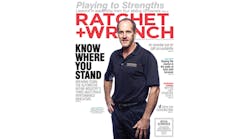Shop owner Brian Johnson just couldn’t make time for a thorough hiring process. His shop needed a new technician, and it needed one fast. So, his staff quickly went through their normal routine: résumé, interview—welcome aboard!
The result was an employee with all the skills to succeed—and an attitude and personality to ensure he wouldn’t.
“Quite frankly, it was a terrible hire, and that’s my fault,” says Johnson. “You get the wrong person in there, and not only are you making a mistake with that person, but you’ve also damaged your team.”
Despite his 30 years of experience, the last 14 as owner, at Motoring Auto Services in Kennewick, Wash., Johnson made what he considers to be the most common—“Too common,” he says—mistake in the industry: Hiring the wrong employee.
Industry consultant Dave Schedin estimates that just 50 to 55 percent of all shop employees would be considered “peak performers,” a term he uses to describe individuals with the proper characteristics to do a job successfully.
“Most shops, you go do an interview, and it’s all subjective; you go off of gut feel about the candidate,” Schedin says. “You need an objective way to look at it, you need an objective way to measure what you’re looking for.”
The key to finding these top employees and placing them in the proper positions in your business, Schedin says, starts with a shop’s hiring process. Taking a thorough and objective approach to interviewing and hiring not only helps identify top candidates, it can be the difference between overall shop success and failure.
Preventing a Six-Figure Mistake
At a recent seminar, Schedin crunched the numbers for his audience. Using a formula implemented by many top U.S. corporations to measure value in individual employees, Schedin showed that a repair shop loses, on average, $137,000 annually in potential revenue for each non-peak performer it employs. The formula takes into account how employee productivity impacts billable hours and overall sales.
Numbers vary depending on the employee’s position and the location of the shop, but Schedin says that a peak performer at any facility makes immense differences in proficiency, sales and overall success, which greatly affects the bottom line.
“It’s a costly mistake,” Schedin says of hiring the wrong person.
Schedin’s company, CompuTrek Automotive Management Systems, devised a process to help shops prevent it.
After his recent hiring mishap, Johnson sought Schedin’s help to find a new technician. Schedin, as with all of his clients, helped Johnson institute a five-step procedure for getting the most objective information out of the interviewing process.
Step 1: The Job Description
Schedin’s team starts by helping put together a thorough point-by-point “job description” that serves as a checklist for what the peak performer in that position would look like. He does this through a 67-question survey that the shop owner fills out.
Only 10 percent of these attributes should relate to skills, experience and education, Schedin says. The rest deals with what he calls the “essence of the person,” which includes thinking styles, behavioral traits, and career interests.
Johnson says all shop owners can start the process by making this sort of list on their own.
“Write down what the ideal person is, if you had to choose, for this position,” Johnson says. “What are their talents? What is their personality like? All the things that make the ‘perfect person.’ You don’t ever get that perfect person, but if you had a choice, that’s what you’d want.”
He then has other shop employees—his manager, his techs, his service advisors—add their input.
This description, Schedin says, is then the basis for the entire process.
Step 2: The Initial Interview
Johnson thinks of this stage as a “feeler” interview, and he handled this one himself. This comes after the basic run-through of resumes and consists of a solid-sized pool of potential candidates. The goal is to identify the strongest candidates for the later, more thorough stages of the process.
Schedin says this should be kept to roughly 30 minutes and is used to get a general idea of the candidates thinking styles (can they do the job?), behavioral traits (how will they do the job?) and occupational interests (do they really want to do the job?). Schedin provides the questions for his clients. Some examples:
• Why is the candidate looking for a new position? (Were they unhappy? Did they voice their displeasure? How did they do that?)
• Where do they see themselves in 3 to 5 years? In 10 years?
• What’s their overall objective for this job?
• What’s their overall career objectives?
Schedin says a shop owner should be looking for how the answers align with the job description they created.
Step 3: The Second Interview
After the first interview, Johnson identified several of his strongest candidates and passed them along to his service manager for the second interview—a more comprehensive look at four key areas of the person’s character: integrity level, substance abuse, work ethic, as well as honesty.
“I try to have as many people as I can be involved in the interview process,” Johnson says. “They’re the ones who have to work with them day in and day out. If I don’t have their buy-in, then I’ve lost.”
The second interview is much longer, Schedin says, roughly about an hour to an hour and a half. He says to not keep a time limit on this and let it go as long as needed.
The questions can be straight-forward (asking them to describe themselves in each of those four areas), experiential (asking them to go over past experiences that demonstrate those areas) and situational (asking them to describe how they would handle key situations in the shop that reveal aspects of those areas). This step should help to narrow down the candidates to a group of finalists.
Step 4: Online Profile
With the remaining candidates, Schedin’s clients then have them fill out an online profile. Schedin uses ProfileXT from Profiles International, Inc.
The candidates answer a series of questions, and the program then provides a thorough profile depicting the candidate’s attitude, personality and behavioral tendencies. Both the shop owner and the candidate get a copy of the results.
At this point in his process, Johnson had just two candidates remaining. He says, ideally, he would have had five or more still to choose from.
Shop owners can create profiles on their own, based on the results of the interviews, although using a program such as ProfileXT increases accuracy and makes the profile much more thorough; it also saves a lot of time. Profiles International Inc. offers both unlimited usage and a la carte purchases for ProfileXT, the latter roughly ranging from $150-200 per use.
Step 5: Additional Questions
Either from the results of the profile or from the two interviews, there still may be some lingering questions or concerns a shop owner may have before pulling the trigger on hiring.
Schedin stresses the importance of not making a hire until a shop owner is extremely confident in the candidate’s ability to succeed in the position.
Don’t be afraid to keep asking questions, Schedin says.
Johnson says he made sure every current employee in his shop had the chance to at least meet the candidate before making the final decision.
The Final Result
The whole decision, Schedin says, correlates to how closely the candidate’s attributes align with the job description.
“When you get a 70 to 75 percent match,” Schedin says, “we start to consider them to have a resemblance of a peak performer.”
An average, solid performer will score in that 70 to 75 percent range, and as the score gets higher, the better the match the employee is for the job. Candidates scoring above 85 percent are few and far between, and anyone in the 90s is considered to be an exceptional match.
Johnson says he shot for a minimum of 80 percent—and he got it in his final choice. This latest hire has been successful from day one, Johnson says.
“Everybody bought into him, everybody wanted him to succeed,” Johnson says, “and he stepped in and his billing hours were like he’d been here for
five years.”
Schedin says shops have to be patient through the process. The biggest mistake most owners make, he says, is rushing to find a replacement. Two months is a realistic amount of time to expect if you want to find a top-level employee, Schedin says.
Also, shops should be sure to do the proper background checks—criminal records, credit, job history, references, etc.—throughout the process.
As far as improving business numbers, Schedin says his average client increases revenues by more than $200,000 in the first 12 months. He says that a lot of that can be attributed to either hiring peak performers or training current employees to become peak performers.
“It’s like any other aspect of your business,” Schedin says. “You need a tangible, objective way to approach it. You need a system in place that you can repeat, and that you can get results from.”


